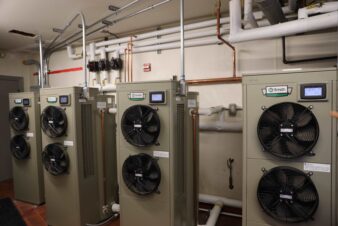To recognize the important work code officials are charged with, week two of the International Code Council’s Building Safety Month 2013 campaign, May 13-19, focuses on disaster safety and mitigation. Sponsored by BASF–The Chemical Company, disaster safety and mitigation in the built environment is the result of the work of Code Council Members and others who create the building codes and standards used to design and build safe, sustainable, affordable and resilient structures.
Code officials inspect homes and buildings during construction and remodeling to ensure public safety and make sure the places where you live, work and play are safe. Safety results from building stairs to proper dimensions, following structural guidelines, and creating hazard-free plumbing, electrical and mechanical systems. Structures also need to be accessible and energy-efficient.
Natural disasters often drive mitigation. New Jersey Governor Chris Christie issued an emergency order after Superstorm Sandy requiring buildings be constructed with codes designed to withstand waves on top of floodwaters. New York Governor Andrew Cuomo said the next generation’s infrastructure must be able to withstand another storm. We must also reduce the energy consumption that contributes to climate change—which means, for starters, upgrading our building codes, he said.
Stronger building codes reduce the risk of injury, death and property damage. Published by the ICC, the I-Codes, are minimum safeguards for all types of structures. Code updates are often the result of lessons learned and technological advances. Code officials and other building safety experts will meet this fall at the ICC Annual Conference and Public Comment Hearings in Atlantic City, N.J., to create the next generation of building safety codes. All 50 states and the District of Columbia have adopted the I-Codes at the state or jurisdictional level. Several federal agencies also use the I-Codes.
The public also has a role in disaster safety and mitigation. Families should develop a disaster plan that includes a list of food, water, medical and other supplies to survive until rescuers arrive after an earthquake, flood or other natural disaster. To ensure remodeling projects are completed safely and meet code, consumers should contact their local building department to determine when a building permit is required.
Standards work hand-in-hand with codes to address natural disasters and public safety. The Standard for Residential Construction in High-Wind Regions specifies wind-resistant construction design for homes that might be impacted by storms with winds of more than 100 mph. The Accessible and Usable Buildings and Facilities standard makes sites, facilities and buildings accessible and usable by people with physical disabilities. The National Green Building Standard provides practices for new homes that at the highest level can result in energy savings of 60 percent or higher.
Learn more about Building Safety Month at www.buildingsafetymonth.org.




Join the conversation: